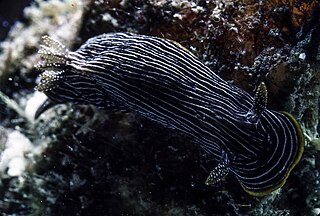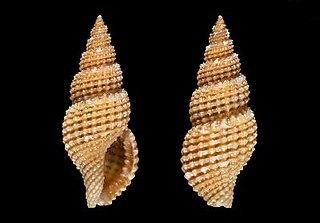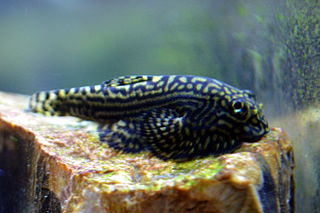
The sleepy cod is a medium-sized fish in the family Butidae, native to tropical fresh waters of northern Australia and questionably from New Guinea. It is a member of the order Perciformes, thus is unrelated to the true cods in the order Gadiformes. Neither are they closely related to the Australian freshwater cods such as the Murray cod of the genus Maccullochella.

Ellipsaria lineolata is a species of freshwater mussel, an aquatic bivalve mollusk in the family Unionidae, the river mussels. This is the sole species in the monotypic genus Ellipsaria . This species is native to the drainage systems of the Mississippi River, the Mobile River, the Tennessee River, and the Cumberland River in the United States. It exists in the midwestern United States, and has also been observed in the east coast and as far south as the Gulf of Mexico. The common name of Ellipsaria lineolata is the Butterfly Mussel.

Nembrotha lineolata is a species of nudibranch, a sea slug, a marine gastropod mollusk in the family Polyceridae. It is found in shallow water in the Indo-Pacific. It was first described in 1905 by the Danish malacologist Rudolph Bergh. The type locality is Selayar Island, Indonesia.

Chromodoris lineolata is a species of colourful sea slug, a dorid nudibranch, a marine gastropod mollusc in the family Chromodorididae.

Raphitoma lineolata is a species of sea snail, a marine gastropod mollusk in the family Raphitomidae.

Echinolittorina lineolata is a species of small sea snail, a marine gastropod mollusc in the family Littorinidae, the winkles or periwinkles.

Ophthalmolepis lineolata, the southern Maori wrasse, is a species of wrasse endemic to the Indian Ocean coastal waters of Australia. This species has been found at a minimum depth of 60 m (200 ft). This species grows to 40 cm (16 in) in total length. This species is the only known member of its genus.
Diadelia is a genus of longhorn beetles of the subfamily Lamiinae, containing the following species:

Batocera lineolata is a species of beetle in the family Cerambycidae. It was described by Louis Alexandre Auguste Chevrolat in 1852. It is known from China, Korea, Japan and Taiwan.
Diadelia flavicollis is a species of beetle in the family Cerambycidae. It was described by Breuning in 1957.
Diadelia griseata is a species of beetle in the family Cerambycidae. It was described by Breuning in 1957.
Diadelia lignea is a species of beetle in the family Cerambycidae. It was described by Breuning in 1940.
Diadelia ochreovittata is a species of beetle in the family Cerambycidae. It was described by Breuning in 1970.
Diadelia densemarmorata is a species of beetle in the family Cerambycidae. It was described by Breuning in 1964.
Diadelia laeviceps is a species of beetle in the family Cerambycidae. It was described by Breuning in 1942.

Iris acutiloba subsp. lineolata is a species in the genus Iris, it is also in the subgenus of Iris. It is a subspecies of Iris acutiloba, and is a rhizomatous perennial, from the mountains of Iran, Turkey, Turkmenistan, Tajikistan and Azerbaijan. It has narrow, lanceolate, or falcate (sickle-shaped) leaves, which are grey-green and glaucous. It has a slender straight stem holding one terminal flower. The flowers, come in shades of white, cream, or creamy white and have veining that is purple or brown, or a mixture of both. It is heavily veined or streaked in purple or brown, with a dark purple-brown, spot on 3 of the outer petals and brown, dark purple, or black short beard. It is rarely cultivated as an ornamental plant in temperate regions, unless grown in a greenhouse.

Acacia lineolata, commonly known as dwarf myall, is a species of shrub in the family Fabaceae. It is endemic to an area of south western Australia.

Crematogaster lineolata is a species of ant in the family Formicidae.

Sepioloidea lineolata or more commonly known as the striped pyjama squid or the striped dumpling squid is a type of bottletail squid that inhabits the Indo-Pacific Oceans of Australia. The striped pyjama squid lives on the seafloor, often hiding in the sand. When fully mature, a striped pyjama squid will only be about 7 to 8 centimetres in length. Baby striped pyjama squid can be smaller than 10 millimetres (0.39 in).

Sewellia lineolata, the reticulated hillstream loach, is a species of fish from the provinces of Thua Thien-Hue, Quang Nam, Quang Ngai and Binh Dinh in Vietnam.












